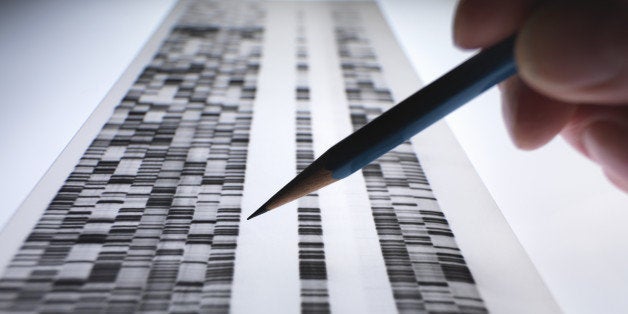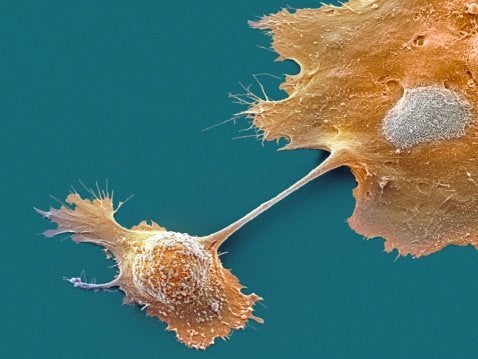
Breast cancer prevention usually starts with breast self-exams in your 20s and progresses to yearly mammograms in your 40s.
But if genome sequencing costs keep going down and knowledge about breast cancer risk genes keeps going up as it has, breast cancer prevention could start as early as birth, according to a new study in the journal Cancer Epidemiology, Biomarkers & Prevention.
“The framework of our study was to ask how useful genome sequencing would be for targeting breast cancer prevention, assuming that genome sequencing were affordable and could be performed on every girl at birth,” said Dr. Weiva Sieh, M.D. Ph.D., a Stanford epidemiology professor, in a phone interview with HuffPost. “In the best case scenario, we found we would be able to identify 70 percent of all future cases by targeting the top 25 percent of women [at risk],” she concluded.
Assessing individual risk factors is important, said Sieh, for those who are most likely to get the disease. For example, if you knew that your genome placed you at a 30 percent of lifetime risk of developing breast cancer, making lifestyle choices like prioritizing exercise, giving birth earlier in life or breast feeding for longer (all known to protect women against breast cancer) could cut your risk in half -- 15 percentage points. But for those who might only test at 4 percent risk for breast cancer on the other hand, cutting the risk of the disease in half would only result in a two-point drop.
In other words, said Sieh, knowing that the risk is written into your genes, could be a good motivator for lifestyle change.
“One of our main messages is that women who are at high risk have the most to gain from modifying lifestyle factors like maintaining a healthy weight or limiting alcohol and smoking,” said Sieh. “The protective effects of these healthy behaviors are multiplicative.”
Sieh’s study, undertaken with Stanford professor Alice Whittemore examined previous studies that established links between 86 different gene variants and breast cancer risk. Those studies also contained genetic information about tens of thousands of women. Sieh and Whittemore then created a statistical computer model using that data to calculate a woman’s risk for breast cancer: however many cancer-related genes a woman has, multiplied by the effects of the variants.
Sieh found that, given everything we know right now about breast cancer-related genes (86 variants in total), genome sequencing could identify about 50 percent of all future breast cancer cases among women who have the highest risk. Since her study was conducted however, researchers have discovered several more breast cancer-related genes (in yet unpublished research, Sieh explained), and the number is only sure to grow.
Once we get a complete picture about all the genes that are associated with breast cancer risk, said Sieh, her computer model could predict up to 70 percent of all future cases.
Cancer patients or people who seem to be at high risk for cancer can already take advantage of genome sequencing, which assesses the approximately 3 billion pairs of DNA molecules you have and tries to measure risks or susceptibilities to certain diseases and characteristics.
Back in 2003 when he was first diagnosed, Apple founder Steve Jobs paid $100,000 to have his entire genome, as well as his tumors, sequenced, to see if doctors could identify how the cancer was growing and find clues on how to stop it.
A lot has changed since then. Now the price tag for whole genome sequencing is around $5,000, according to the science journal Nature, and the U.S. government’s ultimate goal is to lower that cost to $1,000. There’s also a growing movement of people who are taking their genome and using it to make proactive decisions about their health.
Angelina Jolie famously underwent a preventive double mastectomy after learning that she carried the BRCA 1 gene -- a gene that confers a very high lifetime breast cancer risk to the people who have it. Her doctors pegged her at 87 percent risk of breast cancer, but the risk dropped to 5 percent after her surgery, she wrote in an op-ed for the New York Times. Since her op-ed was published, referrals for genetic testing in the U.K. more than doubled after women recognized they had a concerning family history of breast cancer, just like Jolie, according to a study in the journal Breast Cancer Research.
Prof. Kelly Marcom, director of Duke’s Hereditary Cancer Clinic, thinks that genome sequencing at birth is a “complicated question” but agrees with Sieh that it will eventually become a very important part of helping us understand our bodies and our health.
"There’s been a lot of controversy about how much value is going to be provided by knowing all this really detailed risk allele information,” said Marcom. “[Sieh is] modeling it in a way to show it would help identify and associate those risk alleles with more breast cancer cases than had previously been estimated with some of the other models."
Marcom already uses whole genome and tumor genome sequencing to treat his patients and wasn’t involved with Sieh’s study. Sieh’s study, said Marcom, was a good step toward one day understanding individual risks for disease, which is valuable for steering patients toward the best screening methods and treatments for them.
“It’s all about individual assessment of risk, and enhancing the models that tell us where that risk is coming from,” said Marcom. “This is a step in that direction."
But genome sequencing is not the final word on disease risk factors, Marcom cautioned.
"The initial, somewhat naive optimism -- that it was going to be easy to be able to translate [genome sequencing] into improving people’s health and quality of life -- has met the reality of just how complicated it is, and how biological systems are not linear,” explained Marcom. "The thing about genetic sequence information is that its fairly easily attained and quantifiable in a reproducible way, but that’s a lot harder to do with the other non-genetic risk factors; essentially, the environment."
For instance, how does a doctor measure the amount of risk a person faces after living next to a pollutant-spewing factory for 12 years, or the amount of hormones a woman has been exposed to all her life? Those environmental factors have to be taken into account along with genetic information to truly assess individual risk for any disease, explained Marcom.
"Until we really have that information, and we’ve really demonstrated it prospectively, it’ll be challenging to know what the truth is," Marcom concluded.
